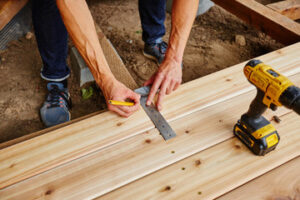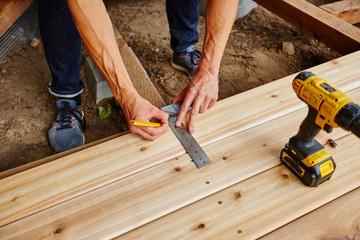Decks can experience significant structural issues from rot and weather damage and may need to be completely replaced. It’s important to hire a professional for these projects to ensure the structure is safe and up to code.
Examine the railings, stairs, and deck surface to make sure all fasteners are secure. Check for sagging or cracked boards and for mold or mildew.
Cracked or split planks aren’t just unsightly; they can also be dangerous, especially if someone is walking on them. Fortunately, the vast majority of these problems aren’t serious and can be repaired using basic tools and supplies.
The first step is to thoroughly clean the area around the cracks. It’s best to use a pressure washer if possible to get the wood really clean. Next, sand the areas where the cracks are located. Be sure to wear a dust mask and follow the recommended safety rules. Then, rinse the wood to make sure it’s completely dry.
Once the surface of the wood is clean, it’s time to fill the cracks. There are many different types of wood filler available, but it’s important to choose one that is rated for outdoor use and will not shrink or crack in the weather. Most reputable hardware stores sell powdered resin glue that will do the trick. Mix this with water until it forms a thick consistency. Then, use a putty knife to apply the epoxy to the cracks. Be sure to spread it evenly and smooth out any bumps or ridges.
It’s also a good idea to fill any cracks that are less than 6 inches long with a flexible polyurethane caulk. This will help prevent the cracks from getting worse in the future.
If the cracks are longer than that, try unscrewing the board and turning it upside down. The underside of the board is often in better shape than the top side, so you might be able to simply screw it back onto its joists with the undamaged part up.
If you’re unable to fix the cracked boards, it’s probably best to replace them. This will eliminate the potential for safety hazards. If the splits are in the middle of a plank, it might be possible to glue them closed to some extent, but this is usually only successful on hairline splits. On more significant splits, it’s usually easier to rip the board in two, rejoin the two halves, and then glue them together.
Weak Post Connections
Over time, your deck’s wood panels can start to loosen or crack. This is normal, especially if your deck is older, but you may want to consider replacing the planks and railings with a new, more durable material. Loose or cracked planks are a safety hazard and could fall and damage your property. Additionally, splinters from the natural wood can injure bare feet and hands.
The joists and beams underneath your deck keep it sturdy, so check that they aren’t sagging or showing signs of rot or softening. If your deck isn’t stable, it could fall and hurt guests or family members who use it.
Weak post connections are another reason to inspect your deck. If your posts are rotting or not attached to the rim joists and beams, the structure of your deck will be compromised. You can fix this problem by installing steel splints, such as E-Z Mender, to strengthen the post and fasten it to the joists.
Ledger flashing is a crucial element of your deck’s design. It prevents water from seeping into the ledger board, which connects your deck to your house. Without it, moisture can build up behind the ledger board and cause rot and structural failure. Examine your deck for rust or gaps between the ledger and the house to determine whether it needs replacing.
Posts can also rot if they are not set in concrete and exposed to the elements. Inspect your posts regularly and replace them as needed.
A power wash and chemical treatment can usually restore a rotting deck and eliminate mildew for a couple of hundred dollars. If your deck’s wood is old, however, you might need to replace it completely. If you’re considering repairing your deck, consider replacing it with a composite material that will last longer than natural wood. It will also require less maintenance and upkeep, such as staining and sealing. This will save you money in the long run. It’s also a smart idea to have a professional inspect your deck for mold, mildew, and termite infestations to ensure it is safe for family and friends.
Mold or mildew
Mold or mildew can quickly cause structural damage to your deck. Like rotten planks, they can degrade the integrity of the entire structure and create holes in the deck surface. Moreover, they can also release spores that can trigger a variety of health problems, especially in infants and people with preexisting respiratory conditions.
Despite their similar appearance, mold and mildew shouldn’t be treated the same. Both are fungi that grow when exposed to excessive moisture and thrive in warm and dark places. But they have striking differences that make it easy to distinguish between them.
Mildew is soft and powdery, whereas mold has a slick texture and often has a raised or fuzzy appearance. Additionally, mildew only grows on the surface of the wood, while mold can penetrate into the material as well.
To remove mildew, you can use a bucket of water mixed with detergent or a scrub brush and a garden hose to rinse the deck surface. You can also buy oxygen bleach, which is a milder alternative to chlorine bleach that doesn’t harm the environment. Mix it with warm water until it reaches a cake batter consistency, and spread the solution on mildewed areas of your deck. Scrub the area with a scrub brush and rinse off the solution using a garden hose.
While you’re cleaning, be sure to wear rubber gloves and a mask if you’re particularly sensitive. Mold spores can trigger a number of respiratory issues, including shortness of breath and coughing. In addition, black mold can cause mycotoxicosis, a condition that causes headaches, memory loss, and a wide array of physical symptoms.
The best way to prevent mold or mildew is by removing organic debris from your deck regularly and ensuring that the underside of the boards stays dry. You can do this by clearing out planters and other furniture that might block the evaporation of moisture from underneath your deck. Additionally, you should install a ventilation system to reduce the amount of moisture that collects under your deck. This will also help to minimize the amount of algae that forms on your deck.
Wood Rot
Wood rot is more than just an eyesore; it can be a major health risk for you and your family. It’s caused by a specific type of fungus that attacks and digests wood over time. It thrives in damp environments and can spread quickly, especially in areas that are exposed to moisture. It’s important to keep an eye out for the early signs of wood rot, as they can be difficult to spot.
If left untreated, rot can lead to structural damage and may cause your deck to collapse. It’s also a safety hazard for anyone using the deck. In some cases, rot can be so severe that it’s actually more cost-effective to remove the entire deck and replace it with a new one. If the rot is only found in one area, though, it can often be repaired.
Wet rot is the most common form of wood rot. It happens when the wood becomes soft and spongy from contact with water, especially if it’s been damp for a while. This can happen around windows, door frames, and anywhere else that’s frequently exposed to moisture. This type of rot can also affect plaster and wallpaper.
Dry rot is less common but just as dangerous. It’s caused by a different species of fungus and is harder to identify than wet rot. It can be distinguished by a deeper crack in the wood that shows through the paint, as well as by white sheets or mushroom-like growths on the surface of the wood.
If you think you have a problem with either type of wood rot, you should act quickly. In both cases, the first step in the repair process is to remove all of the affected wood. Afterward, it’s a good idea to treat the surrounding wood with a fungicide to kill any spores that remain.
To prevent the fungus from returning, make sure all areas of your deck are properly caulked and that your rain gutters are in good condition. You can also use a dehumidifier or regularly open windows to help reduce condensation.

